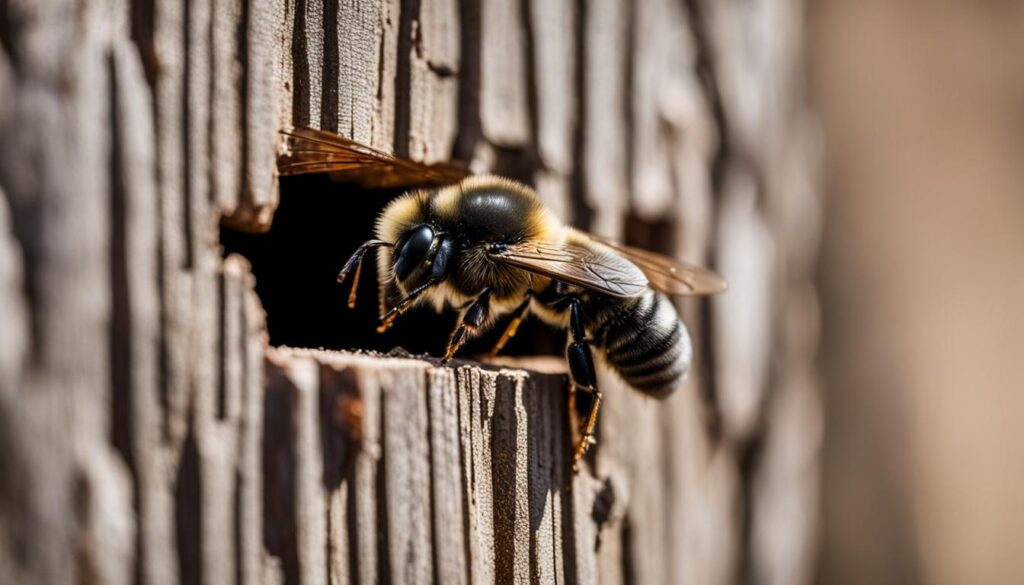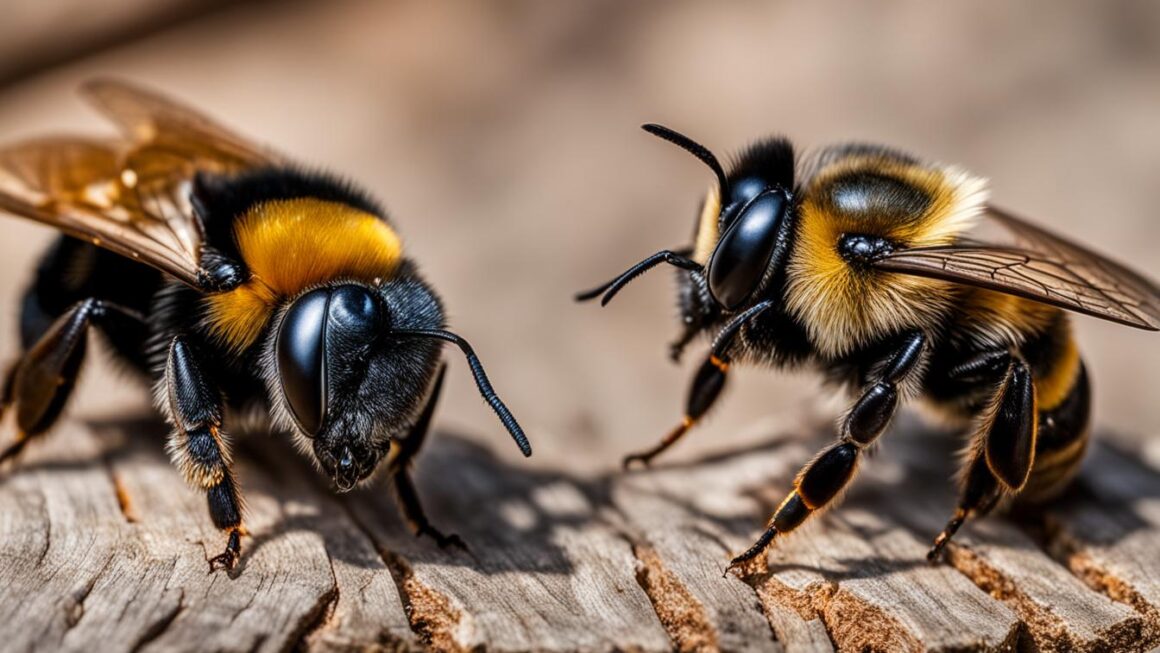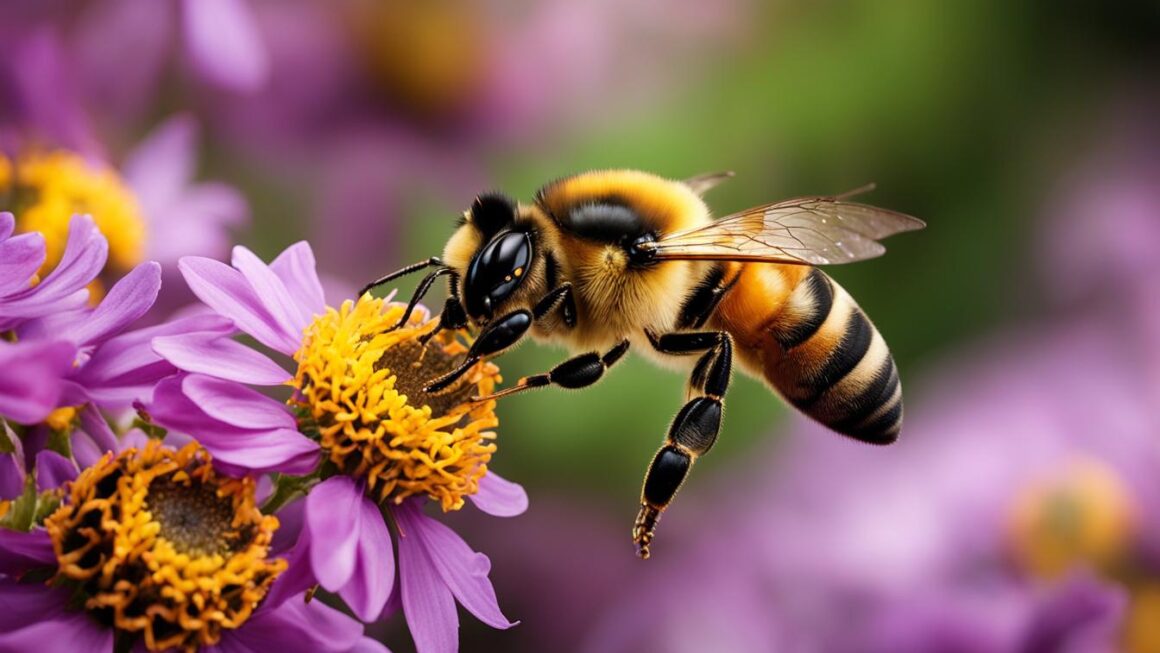Welcome to our comprehensive guide on mason bees and carpenter bees. As homeowners, it is crucial to understand the differences between these two common types of bees, as they can have a significant impact on your home and the ecosystem. In this article, we will explore their unique characteristics, nesting habits, pollination differences, physical appearance, and more.
So, let’s dive right in and discover the fascinating world of mason bees and carpenter bees!
Key Takeaways:
- Mason bees and carpenter bees are two common types of bees with distinct characteristics.
- Carpenter bees nest in untreated wooden surfaces, while mason bees nest in small units or families.
- Mason bees are efficient pollinators, while carpenter bees are known as “nectar robbers.”
- Mason bees have a smaller and fuzzier appearance, while carpenter bees are larger and bare-bodied.
- Proper identification is crucial for effective control and conservation efforts.
Types of Bees: Carpenter Bees, Bumblebees, Mason Bees, and Hornets
When it comes to bees, there is a wide variety of species found in North America. Understanding the different types of bees can help homeowners better identify them and make informed decisions regarding their presence on their property. Some of the most common types of bees include carpenter bees, bumblebees, mason bees, and hornets.
Carpenter Bees
Carpenter bees are known for their ability to drill into untreated wooden surfaces, such as roofing, siding, and exterior paneling of homes. They create their nests by burrowing into the wood, which can cause structural damage over time. Eastern carpenter bees resemble large bumblebees, while valley carpenter bees have distinct differences in appearance.
Bumblebees
Bumblebees are larger, robust bees known for their fuzzy bodies and loud buzzing sounds. They are important pollinators and are known to live in colonies. Bumblebees build their nests in the ground, in abandoned rodent burrows, or in dense grass or vegetation. They are generally non-aggressive but may sting if they feel threatened.
Mason Bees
Mason bees are smaller bees with a distinct metallic blue or green shine. They are gentle pollinators that are welcomed in suburban backyards. Unlike carpenter bees, mason bees do not cause damage to wooden structures. They nest in small units or families and are highly efficient at pollinating plants.
Hornets
Hornets belong to the wasp family and are not bees, but they are often associated with them due to their similar appearance. Hornets live in traditional, aboveground nests governed by a queen. They are larger than bees and have a more aggressive nature. Hornets can sting repeatedly and construct their nests by chewing up wood pulp.
| Bee Species | Appearance | Nesting Habits |
|---|---|---|
| Carpenter Bees | Resemble large bumblebees | Drill into untreated wooden surfaces |
| Bumblebees | Large and robust with fuzzy bodies | Build nests in the ground or vegetation |
| Mason Bees | Small with a metallic blue or green shine | Nest in small units or families |
| Hornets | Large and aggressive, similar to bees | Construct aboveground nests with wood pulp |
Carpenter Bees: Wood Drillers and Nesting Habits
Carpenter bees are fascinating creatures with unique nesting habits. Unlike other bees that build their nests underground or in hives, carpenter bees prefer to make their homes in untreated wooden surfaces. They are particularly attracted to roofing, siding, and exterior paneling of homes. The females of this species are the ones responsible for drilling into the wood to create their nests, while the males play a protective role. Eastern carpenter bees resemble large bumblebees, while valley carpenter bees have distinct differences in appearance.
These wood-drilling bees are solitary insects, meaning they do not live in colonies or hives. Instead, each female carpenter bee finds her own nesting place and constructs her own individual tunnels within the wood. This behavior can lead to significant damage to wooden structures over time, as the bees continue to expand their tunnels year after year.
It’s important to note that carpenter bees are not aggressive and typically only sting if they feel threatened. However, their nesting habits can still be problematic for homeowners. If left untreated, carpenter bee infestations can cause structural damage to homes and other wooden structures. Therefore, it is crucial to take appropriate measures to control and prevent these bees from nesting in areas where they can cause harm.
Distinguishing Carpenter Bees from Other Bees
While carpenter bees may resemble other bees in some aspects, there are distinct characteristics that set them apart. The most noticeable difference is their nesting behavior, as carpenter bees are the only bees that tunnel into wood. Additionally, their size and appearance can help differentiate them from other bee species.
By understanding the nesting habits and physical characteristics of carpenter bees, homeowners can better identify and address any infestation issues. Taking prompt action can help protect wooden structures from damage and ensure a harmonious coexistence with these fascinating wood-drilling insects.
Mason Bees: Gentle Pollinators and Nesting Habits
Mason bees are valuable contributors to the ecosystem as gentle pollinators. Their efficient pollination abilities make them welcome guests in suburban backyards. These bees have unique nesting habits that set them apart from other bee species.
Mason bees are known for their industrious nature. Females are responsible for the majority of the nest-building process. They create their nests in small units or families, using existing cavities like hollow stems, holes in wood, or even abandoned nests of other insects. The female mason bee meticulously constructs individual cells within the nest, where she lays her eggs and collects pollen for her offspring.
“Mason bees are gentle pollinators that help support healthy ecosystems with their efficient pollination abilities.”
The male mason bees, on the other hand, are less involved in nest construction. Their primary role is to mate with the females and protect the nesting site from potential threats. Male mason bees are known for their territorial behavior, and they often patrol the surrounding area to ward off intruders.

| Nesting Habits | Mason Bees | Carpenter Bees |
|---|---|---|
| Preferred Nesting Sites | Existing cavities like hollow stems and holes in wood | Untreated wooden surfaces like roofing and siding |
| Mating Behavior | Females construct individual cells within the nest and lay eggs; males protect the nesting site | Females drill into wood to create nests; males play a protective role |
| Abundance | Large populations can be established through artificial nesting sites like bee houses | Smaller population sizes compared to mason bees |
Mason bees have a unique appearance that sets them apart. They are smaller and fuzzier compared to carpenter bees. Their metallic blue or green shine and fuzzy abdomen make them easily recognizable. Observing these physical characteristics can help distinguish mason bees from other bee species.
Hornets: Wasp Relatives and Nesting Habits
Hornets are not bees but belong to the wasp family. They are known for their aggressive nature and powerful stings. Hornets live in traditional, aboveground nests, which are often found hanging from various structures such as trees, eaves, or bushes. These nests are composed of chewed-up wood pulp, which the hornets use to construct their intricate homes.
The nests are built by the queen hornet, who lays eggs and oversees the activities of the colony. Hornets are highly territorial and will defend their nests aggressively, making them a potential threat to humans and pets. Unlike male hornets, which lack stingers, the females possess a stinger and can sting repeatedly.
“Hornets are territorial and can sting repeatedly, unlike male hornets that lack stingers.”
It’s important to note that hornets play an essential role in the ecosystem as they help control populations of other insects. However, if hornets pose a threat to human safety or are causing significant damage to structures, professional intervention may be necessary to remove the nests safely and effectively.

Hornets Nesting Habits
Understanding the nesting habits of hornets can help homeowners identify and address potential issues. Hornets typically build their nests in protected locations, such as tree branches, porches, or attics. These nests can be quite large, with some reaching the size of a basketball or larger. Hornets prefer to build their nests in areas that offer shelter from the elements and easy access to food sources.
When addressing hornet nests, it’s important to exercise caution and seek professional assistance if necessary to ensure the safety of yourself and others. Attempting to remove or disturb a hornet nest without proper knowledge and protective gear can result in stings and injury.
Table: Comparison of Bee Nesting Habits
| Carpenter Bees | Mason Bees | Hornets | |
|---|---|---|---|
| Preferred Nesting Materials | Wood | Natural cavities or pre-made tubes | Wood pulp |
| Location of Nests | Untreated wooden surfaces | Small units or families | Protected areas (e.g., tree branches, attics) |
| Nesting Behavior | Females drill into wood to create nests | Females construct nests using mud or clay | Queen hornet builds and oversees nest construction |
| Stinging Behavior | Females can sting but are typically non-aggressive | Males lack stingers, females sting infrequently | Females can sting repeatedly and are highly aggressive |
Pollination Differences: Mason Bees vs Carpenter Bees
Mason bees and carpenter bees, while both important pollinators, differ in their pollination techniques. Mason bees are highly efficient pollinators, with a single female capable of pollinating over 2,000 plants a day. They gather pollen dry on their underbelly coat, allowing for easy transfer from flower to flower. This method results in effective pollination and contributes to the reproduction of various plant species.
On the other hand, carpenter bees are known as “nectar robbers” and are not as efficient at pollination. They are more focused on accessing the nectar of flowers rather than collecting and transferring pollen. When they insert their proboscis into the flower, they often bypass the reproductive structures and, in turn, reduce the chances of successful pollination.
“Mason bees are excellent pollinators, with their hairy bodies serving as efficient vehicles for pollen transport. They collect pollen dry on their bodies, ensuring effective pollination of plants.
It is important to note that while carpenter bees are not as effective at pollination, they still play a role in the natural ecosystem. Their presence can help with some pollination, especially if other pollinators are scarce. However, the reliance on carpenter bees alone may result in reduced plant reproductive success compared to a diverse mix of pollinators, including mason bees.
Pollination Differences: Mason Bees vs Carpenter Bees
| Mason Bees | Carpenter Bees | |
|---|---|---|
| Pollination Technique | Efficient and effective | Less efficient, focus on accessing nectar |
| Pollen Collection | Collect pollen dry on their bodies | Do not collect and transfer much pollen |
| Reproductive Impact | Significant contribution to plant reproduction | Less significant compared to mason bees |
| Role in Ecosystem | Important pollinator | Plays a supporting role in pollination |
The table above summarizes the key differences in pollination between mason bees and carpenter bees. While both have their role in the ecosystem, mason bees have a more significant impact on plant reproduction due to their efficient pollination techniques.
Physical Characteristics: Mason Bees vs Carpenter Bees
Mason bees and carpenter bees may share similarities in their behaviors and impact on the ecosystem, but they have distinct physical characteristics that set them apart.
One noticeable difference is their size. Mason bees are generally smaller than carpenter bees. The size of mason bees can vary depending on the species, but they are typically around 10-20 millimeters long. In contrast, carpenter bees are larger, measuring between 12-25 millimeters. This size difference is often visible when observing these bees in their natural habitats.
Another key distinction is their appearance. Mason bees have a more vibrant and colorful appearance compared to carpenter bees. They are often characterized by their metallic blue or green shine, which gives them an eye-catching appearance. In contrast, carpenter bees tend to have a bare-bodied appearance, with little to no hair covering their bodies. Their bodies are usually darker in color, ranging from black to dark brown.
Observing the abdomen of the bees can also help differentiate between the two. Mason bees typically have a fuzzy abdomen, which is covered in fine hair, giving them a softer and fuzzier appearance overall. On the other hand, carpenter bees have a smooth abdomen, lacking the fine hair seen in mason bees. These physical distinctions can be useful in identifying and distinguishing between these two bee species.
Physical Characteristics Comparison:
| Bee Species | Size | Appearance | Abdomen |
|---|---|---|---|
| Mason Bees | Smaller (10-20mm) | Vibrant, metallic blue or green | Fuzzy |
| Carpenter Bees | Larger (12-25mm) | Bare-bodied, dark in color | Smooth |
Bee Control and Nest Removal
When it comes to dealing with unwanted bees, the approach varies depending on the species. Mason bees, being gentle pollinators, typically do not require any removal as they are not harmful to homes. However, if their nesting habits become problematic, there are passive traps and deterrents available to control them without causing harm.
Carpenter bees, on the other hand, can pose a threat to wooden structures. If you notice signs of carpenter bee activity, such as holes in wood or sawdust piles near nesting sites, it may be necessary to seek professional intervention. Pest control experts can assess the extent of the infestation and implement effective removal strategies, ensuring the preservation of your home’s structural integrity.
When dealing with aggressive species like hornets, it is crucial to exercise caution. Unlike bees, hornets can sting repeatedly, and disturbing their nests can lead to painful encounters. In such cases, it is best to contact a professional pest control service for safe and efficient removal.
Table: Bee Control Methods and Nest Removal
| Bee Species | Control Methods | Nest Removal |
|---|---|---|
| Mason Bees | Passive traps and deterrents | Not necessary, but may require removal if nesting becomes problematic |
| Carpenter Bees | Professional pest control intervention | Professional removal to prevent damage to wooden structures |
| Hornets | Professional pest control intervention | Professional removal to ensure safety |
By employing the appropriate control methods and seeking professional help when needed, homeowners can effectively manage bee populations and ensure the safety and well-being of their homes and surrounding environment.
Image source: https://seowriting.ai/32_6.png
Conclusion
Understanding the differences between mason bees and carpenter bees is crucial for homeowners. Mason bees offer numerous benefits as gentle pollinators, with a single female capable of pollinating over 2,000 plants a day. Their efficient pollination helps promote healthy ecosystems and robust plant growth.
Carpenter bees, on the other hand, can cause damage to wooden structures due to their nesting habits. It is important to identify and address carpenter bee infestations promptly to prevent potential structural issues. Seeking professional intervention may be necessary for effective control and preservation of wooden surfaces.
Both mason bees and carpenter bees play important ecological roles. Mason bees contribute significantly to the pollination of various plants, while carpenter bees aid in the natural process of wood decomposition. Understanding the ecological functions of these bees allows us to appreciate their contributions and work towards their conservation.
To effectively manage these bee species, proper identification is essential. Observing physical characteristics, such as size, appearance, and body coloration, can help differentiate between mason bees and carpenter bees. This knowledge enables homeowners to implement appropriate control measures and conservation efforts to coexist with these fascinating insects.
FAQ
Can mason bees cause damage to wooden structures?
No, mason bees do not cause damage to wooden structures. They are gentle pollinators and do not drill into wood like carpenter bees.
Are carpenter bees efficient pollinators?
No, carpenter bees are known as “nectar robbers” and are not efficient pollinators like mason bees. They primarily steal nectar without effectively pollinating plants.
How can I differentiate between mason bees and carpenter bees?
Mason bees are smaller and fuzzier compared to the larger, bare-bodied carpenter bees. You can also observe their abdomen and body coloration for further differentiation.
Do hornets belong to the bee family?
No, hornets belong to the wasp family, not the bee family. They create traditional, aboveground nests made of chewed-up wood pulp.
Are mason bees harmful to homes?
No, mason bees are not harmful to homes. They are welcomed in suburban backyards due to their gentle nature and efficient pollination abilities.
What can I do to control yellow jackets and hornets?
Passive traps and deterrents can be effective in controlling yellow jackets and hornets. Professional intervention may be required for carpenter bees if they are causing damage to wooden structures.
How many plants can a single mason bee pollinate in a day?
A single female mason bee is capable of pollinating over 2,000 plants in a day. They carry dry pollen on their underbelly coat, allowing for efficient pollination.
Do male hornets have stingers?
No, male hornets lack stingers and cannot sting. Only the females have stingers and can sting repeatedly.
Should I remove mason bees from my property?
Mason bees typically do not require removal as they are beneficial pollinators and not harmful to homes. They play an important ecological role in the ecosystem.
When should I seek professional intervention for carpenter bees?
If carpenter bees are causing damage to wooden structures such as roofing, siding, or exterior paneling of homes, it is recommended to seek professional intervention for effective control and conservation efforts.




